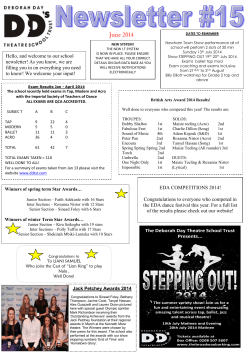
Superflares in G, K and M Type Dwarfs Simon Candelaresi , Andrew Hillier
NORDITA Superflares in G, K and M Type Dwarfs Simon Candelaresi1,2,3, Andrew Hillier4, Hiroyuki Maehara4,5, Axel Brandenburg2,3, Kazunari Shibata4 Division of Mathematics, University of Dundee, Dundee, DD1 4HN, UK 2 NORDITA, KTH Royal Institute of Technology and Stockholm University, Roslagstullsbacken 23, SE-10691 Stockholm, Sweden 3 Department of Astronomy, AlbaNova University Center, Stockholm University, SE-10691 Stockholm, Sweden 4 Kwasan and Hida Observatory, Kyoto University, Yamashina, Kyoto 607-8471, Japan 5 Kiso Observatory, Institute of Astronomy, School of Science, The University of Tokyo 10762-30, Mitake, Kiso-machi, Kiso-gun, Nagano 397-0101, Japan 1 Introduction Rotation Rate Light curve data from stars, captured by the Kepler satellite, provide insights into stellar flares. Superflares of energies above 1034 erg are observed. We perform a statistical analysis and search for environments under which flares occur more frequently and with higher energies. Magnetic activity is confirmed to be key for flare generation. Spot Coverage Strong magnetic fields are manifested through star spots. Spot coverage can be inferred from periodic brightness variations. We use the relative brightness variation as proxy of star spot coverage. Superflare Sample Kepler observations of light curves from G, K and M type dwarfs in quarters 0 to 6 are used. Total amount of stars: 117661 Superflaring stars: 795 Superflare events: 6830 Analysis Rate of superflare occurrence for individual stars: ● Normalized rate: : convective turnover time ● Inverse Rossby number: → non-dimensionalized rotation rate ● To find any correlation between physical parameters of the stars and the superflare rate, we need to consider averages in intervals of e.g. the effective temperature or the inverse Rossby number. The averaged superflare occurrence rate in such intervals we denote as . Temperature 1-D histogram: averaged brightness variation in dependence of the inverse Rossby number 2-D histogram: probability distribution function of and scatter plot: normalized superflare rates upper histogram: averaged normalized superflare rate lower histogram: averaged normalized superflare rate including non-superflaring stars Two regimes are found: : quadratic increase : linear decrease The break at agrees with Pizzolato et al. (2003) and Wright et al. (2011) who find a quadratic increase of X-ray luminosity. Above the break point stellar activity is saturated. Flare Energy Normalized superflare occurrence rate including all stars in dependence of the relative brightness variation. Increased rotation rate leads to increased magnetic activity and star spot coverage, which leads to higher superflare rates. Conclusions Superflare rates decrease with effective temperature. ● Rates increase with rotation rate up to a saturation point. ● Average flare energy increases with rotation rate. ● Rotation rate enhances magnetic activity. ● Fast rotators show higher spot coverage. ● Magnetic fields are essential for flares. ● 1-D histogram: averaged flare energy in intervals of the inverse Rossby number 2-D histogram: relative population of flares with given inverse Rossby number and energy Dynamo activity increases with the shearing rate, which is a consequence of the rotation. For fast rotators we observe more energetic flares. References ● upper panel: superflare rates for each star central panel: normalized superflare rate lower panel: binned averages of the superflare rate including non-flaring stars With increasing temperature the superflare rate decreases, which is expected from calculations by Kitchatinov & Olemskoy (2011) who showed a decrease in dynamo number with . ● ● Kitchatinov, L. L., & Olemskoy, S. V. 2011, MNRAS, 411, 1059 Pizzolato, N., Maggio, A., Micela, G., Sciortino, S., & Ventura, P. 2003, A&A, 397, 147 Wright, N. J., Drake, J. J., Mamajek, E. E., & Henry, G. W. 2011, ApJ, 743, 48 This work: Arxiv:1405.1453 submitted to ApJ Contact Dr. Simon Candelaresi http://www.maths.dundee.ac.uk/scandelaresi/ simon.candelaresi@gmail.com
© Copyright 2025





















